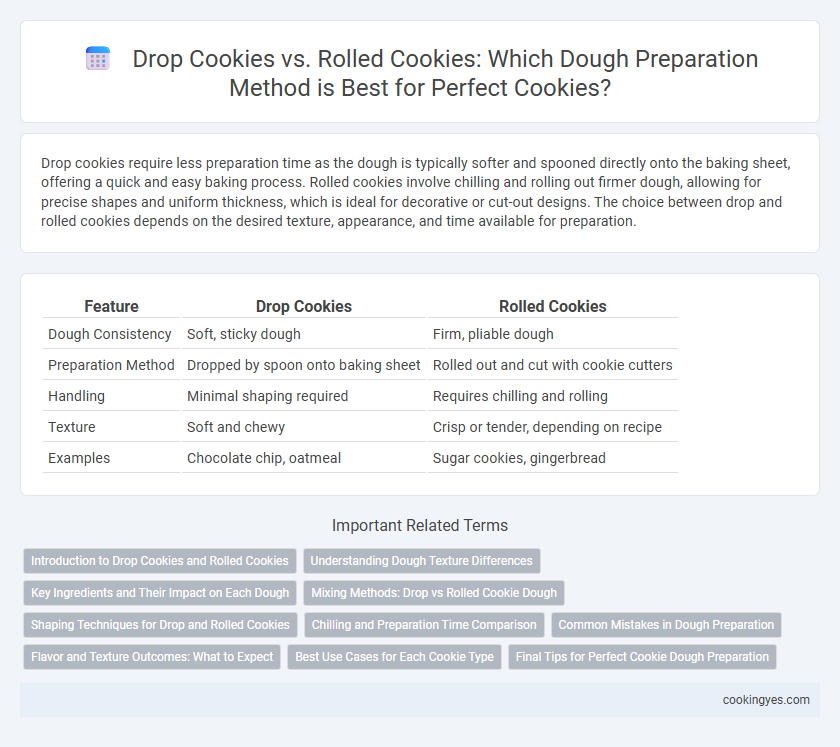Drop cookies require less preparation time as the dough is typically softer and spooned directly onto the baking sheet, offering a quick and easy baking process. Rolled cookies involve chilling and rolling out firmer dough, allowing for precise shapes and uniform thickness, which is ideal for decorative or cut-out designs. The choice between drop and rolled cookies depends on the desired texture, appearance, and time available for preparation.
Table of Comparison
| Feature | Drop Cookies | Rolled Cookies |
|---|---|---|
| Dough Consistency | Soft, sticky dough | Firm, pliable dough |
| Preparation Method | Dropped by spoon onto baking sheet | Rolled out and cut with cookie cutters |
| Handling | Minimal shaping required | Requires chilling and rolling |
| Texture | Soft and chewy | Crisp or tender, depending on recipe |
| Examples | Chocolate chip, oatmeal | Sugar cookies, gingerbread |
Introduction to Drop Cookies and Rolled Cookies
Drop cookies feature a soft, sticky dough dropped by spoonfuls onto a baking sheet, resulting in irregular shapes and a chewy texture, commonly seen in chocolate chip or oatmeal cookies. Rolled cookies involve a firm dough that is chilled, rolled out with a rolling pin, and cut into precise shapes before baking, ideal for sugar cookies and gingerbread. Each method influences the cookie's texture, appearance, and ease of preparation, catering to different baking preferences and occasions.
Understanding Dough Texture Differences
Drop cookies feature a softer, wetter dough that spreads naturally during baking, creating a chewy texture with slightly crisp edges. Rolled cookies require a stiffer dough that holds its shape when cut, resulting in a thicker, firmer bite with uniform thickness and less spreading. The moisture content and fat distribution in drop dough promote softness, while rolled dough's lower hydration enhances structure and allows for detailed shaping.
Key Ingredients and Their Impact on Each Dough
Drop cookies rely on a softer dough with higher moisture content, using ingredients like more butter and liquid sugars that create a chewy, spread-out texture upon baking. Rolled cookie dough incorporates a firmer mixture, often with additional flour and less moisture, allowing it to be chilled and rolled without sticking, resulting in crisp edges and a uniform shape. The variation in fat and flour ratios critically influences the dough's consistency, spreadability, and final bite.
Mixing Methods: Drop vs Rolled Cookie Dough
Drop cookie dough is typically softer and higher in moisture, requiring a gentler mixing method to avoid overdeveloping gluten, which keeps the cookies tender and chewy. Rolled cookie dough is firmer and stiffer, necessitating thorough mixing and chilling to develop structure and ensure even rolling without sticking. Proper mixing methods tailored to each dough type optimize texture and shape retention during baking.
Shaping Techniques for Drop and Rolled Cookies
Drop cookies rely on a spoon or scoop to place irregularly shaped dough mounds directly onto baking sheets, allowing for natural spreading and a rustic appearance. Rolled cookies require chilling the dough, then rolling it out evenly before using cookie cutters to create precise shapes with consistent thickness. Shaping techniques for drop cookies emphasize ease and spontaneity, while rolled cookies demand careful handling and uniformity for decorative, intricate designs.
Chilling and Preparation Time Comparison
Drop cookies require minimal chilling time as the dough is typically soft and ready to scoop immediately, making preparation faster overall. Rolled cookies need extended chilling periods to firm up the dough, allowing for easier rolling and precise shaping, which increases total preparation time. The chilling phase for rolled cookies can range from 1 to 4 hours, whereas drop cookies often bypass this step entirely or require only brief refrigeration.
Common Mistakes in Dough Preparation
Drop cookies often suffer from overmixing, leading to tough, dense texture due to excessive gluten development, while rolled cookies frequently face underchilling of dough, causing spreading and loss of shape during baking. Common mistakes include incorrect flour measurement, which affects dough consistency, and failure to properly cream butter and sugar, resulting in uneven texture and poor rise. Properly chilling rolled cookie dough and gentle mixing of drop cookie dough are essential steps to achieve desired texture and shape.
Flavor and Texture Outcomes: What to Expect
Drop cookies yield a soft, chewy texture with a rich, buttery flavor due to their higher moisture content and minimal handling of the dough. Rolled cookies develop a firmer, crisper texture and a more pronounced buttery taste, attributed to the chilling and rolling process that enhances flavor concentration and creates a uniform thickness. Expect drop cookies to be more rustic and tender, while rolled cookies offer a refined, crisp bite with a delicate balance of sweetness and texture.
Best Use Cases for Each Cookie Type
Drop cookies are ideal for quick, rustic cookies with a soft texture, making them perfect for recipes like chocolate chip or oatmeal cookies where a less precise shape is acceptable. Rolled cookies excel in cut-out shapes and decorative designs, making them the best choice for sugar or gingerbread cookies that require uniformity and a crisp, firm texture. Each method optimizes dough handling and baking results based on the desired cookie style and presentation.
Final Tips for Perfect Cookie Dough Preparation
For perfect cookie dough preparation, ensure drop cookies use a thicker, scoopable dough for uniform shapes and even baking, while rolled cookies require a firmer dough chilled well to prevent spreading during cutting. Use minimal flour to maintain softness and avoid overmixing to keep the texture tender. Chill both dough types appropriately to enhance flavor development and control dough consistency for optimal results.
Drop cookies vs Rolled cookies for dough preparation Infographic

 cookingyes.com
cookingyes.com